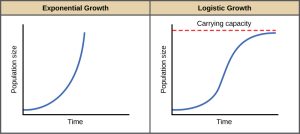8.4 Effect of Density on Populations
A population can grow to a density that exceeds the system’s resource availability, leading to overpopulation. When overpopulation occurs, the population experiences increased competition for limited resources, causing the growth rate to decline. This situation arises when the population exceeds the carrying capacity of the ecosystem, which is the maximum number of individuals that can be sustained by available resources. Overpopulation often results in resource depletion, intensified competition, and a decline in the overall health of the population. 😲
Density-Dependent vs. Density-Independent Factors
Populations face challenges to survival and reproduction due to limiting factors, which are categorized into two types: density-dependent factors and density-independent factors.
Density-dependent factors affect the growth rate of a population based on its density. Examples include competition for resources and predation.
Density-independent factors impact population growth regardless of its density. Natural disasters, such as floods or droughts, are typical examples. 🌊
Density-Dependent Factors
Density-dependent factors affect populations differently depending on their size. As the population size increases, these factors have a more significant impact. Common examples include competition for food, disease, migration, and the presence of predators. A larger population requires more resources and thus faces greater susceptibility to shortages. Among these factors, access to food often has the greatest impact on populations.
Density-Independent Factors
Density-independent factors, such as extreme weather and climate changes, can affect a population regardless of its size. For instance, global climate warming is increasingly impacting populations by causing habitat loss, temperature changes, and food or water scarcity, with potentially devastating effects on many species.
Carrying Capacity
With the limits of density-dependent and density-independent factors in place, populations often follow a logistic growth model. 🧳
The logistic growth model describes how a population’s growth rate changes over time as it approaches its carrying capacity. Initially, the growth rate may be high, but it begins to decline as resources become more scarce and the carrying capacity is reached. Once this point is met, the growth rate stabilizes and the population size approaches equilibrium.
Both types of limiting factors contribute to a population’s carrying capacity, or the maximum number of individuals that can survive in a particular environment. Once carrying capacity is reached, populations can no longer grow exponentially. Instead, ecologists observe logistic growth.

Example: Logistic Growth Calculation
In a population of 862 iguanas, with a per capita growth rate of 0.05 and a carrying capacity of 1000, what would be the change in population after one year? 🦎







